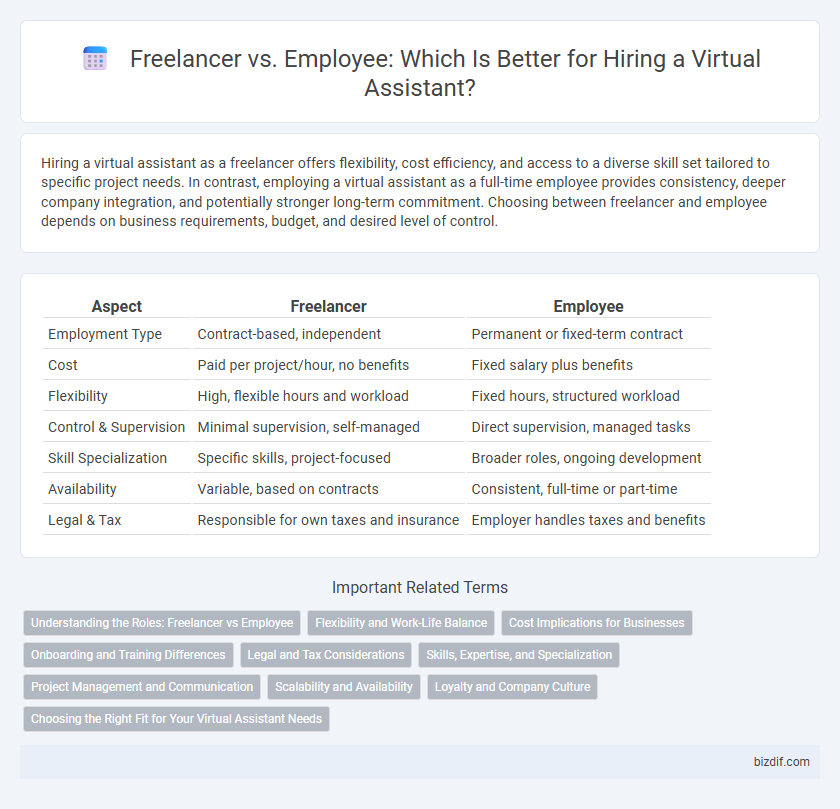Hiring a virtual assistant as a freelancer offers flexibility, cost efficiency, and access to a diverse skill set tailored to specific project needs. In contrast, employing a virtual assistant as a full-time employee provides consistency, deeper company integration, and potentially stronger long-term commitment. Choosing between freelancer and employee depends on business requirements, budget, and desired level of control.
Table of Comparison
| Aspect | Freelancer | Employee |
|---|---|---|
| Employment Type | Contract-based, independent | Permanent or fixed-term contract |
| Cost | Paid per project/hour, no benefits | Fixed salary plus benefits |
| Flexibility | High, flexible hours and workload | Fixed hours, structured workload |
| Control & Supervision | Minimal supervision, self-managed | Direct supervision, managed tasks |
| Skill Specialization | Specific skills, project-focused | Broader roles, ongoing development |
| Availability | Variable, based on contracts | Consistent, full-time or part-time |
| Legal & Tax | Responsible for own taxes and insurance | Employer handles taxes and benefits |
Understanding the Roles: Freelancer vs Employee
Freelancers operate as independent contractors offering specialized services to multiple clients without long-term commitments, while employees work under direct supervision within a company structure, benefiting from stable salaries and organizational resources. Freelancers manage their own taxes, schedules, and client relationships, whereas employees receive benefits such as healthcare, paid leave, and job security. Recognizing these distinctions helps businesses optimize workforce strategies and individuals choose the right career path in virtual assistance.
Flexibility and Work-Life Balance
Freelancers in virtual assistant roles enjoy greater flexibility by setting their own schedules and selecting projects that align with personal preferences, enhancing work-life balance. Employees typically adhere to fixed working hours and organizational protocols, which can limit adaptability but provide structured stability. Balancing these factors, freelancers often achieve more personalized control over their time, while employees benefit from consistent routines and predictable workloads.
Cost Implications for Businesses
Hiring a freelance virtual assistant typically reduces costs by eliminating expenses related to benefits, office space, and long-term commitments associated with full-time employees. Freelancers offer flexible pricing models, allowing businesses to scale services based on workload without incurring fixed salaries or overtime pay. Conversely, employees may provide greater control and consistency but involve higher overhead costs due to taxes, insurance, and equipment provision.
Onboarding and Training Differences
Freelancers experience a streamlined onboarding process with minimal training requirements, leveraging their pre-existing skills and project-specific instructions to quickly integrate into tasks. Employees undergo comprehensive onboarding programs, including orientation, company culture immersion, and continuous training to align with long-term organizational goals. Virtual assistants benefit from these differences by adapting onboarding approaches based on their engagement type, ensuring efficient productivity for freelancers and deeper role integration for employees.
Legal and Tax Considerations
Freelancers operate as independent contractors responsible for managing their own tax filings, including self-employment taxes and estimated quarterly payments, whereas employees have taxes withheld by their employer and benefit from employer-provided tax deductions. Legal considerations for freelancers include drafting clear contracts that outline scope, payment terms, and intellectual property rights, contrasting with employees who fall under labor laws and receive employment protections like minimum wage and benefits. Understanding the distinctions in tax obligations and legal status is crucial for compliance, risk management, and effective financial planning in virtual assistant engagements.
Skills, Expertise, and Specialization
Freelancers offer diverse skills and specialized expertise tailored to specific projects, enabling businesses to access niche talents without long-term commitments. Employees bring consistent, in-depth knowledge of company processes and culture, fostering collaboration and sustained skill development within the organization. Choosing between freelancers and employees depends on the project's complexity, need for specialization, and the desire for ongoing versus flexible resource allocation.
Project Management and Communication
Freelancers offer flexible project management with adaptable communication schedules, often utilizing tools like Trello or Asana for task tracking and Slack or Zoom for real-time updates. Employees, integrated within organizational structures, benefit from more consistent communication channels and aligned project workflows through platforms such as Microsoft Teams and Jira. Effective collaboration depends on clear role definitions and communication protocols tailored to either freelance autonomy or employee integration.
Scalability and Availability
Freelancers offer greater scalability by allowing companies to quickly adjust workforce size based on project demands, enhancing flexibility without long-term commitments. Employees provide consistent availability and deep organizational knowledge, ensuring reliable support and continuity for virtual assistant tasks. Balancing freelancers and employees maximizes operational efficiency and responsiveness in dynamic business environments.
Loyalty and Company Culture
Freelancers offer flexibility but may lack deep loyalty and alignment with company culture compared to full-time employees. Employees typically demonstrate stronger commitment and integration within organizational values, contributing to a cohesive work environment. Maintaining a consistent company culture is often more challenging when relying heavily on freelancers due to their varied client engagements and limited long-term involvement.
Choosing the Right Fit for Your Virtual Assistant Needs
Selecting between a freelancer and an employee for virtual assistant tasks hinges on workload consistency and budget flexibility. Freelancers offer project-based support with scalability and diverse skillsets, ideal for fluctuating demands and cost control. Employees provide dedicated, long-term commitment and company-specific knowledge, benefiting businesses with steady virtual assistant requirements.
Freelancer vs Employee Infographic

 bizdif.com
bizdif.com